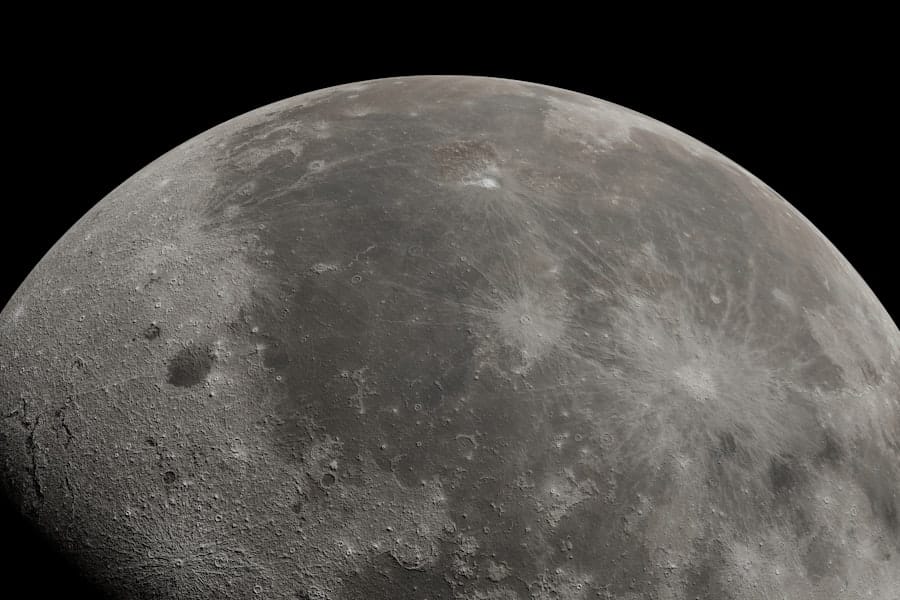The establishment of lunar bases is a pivotal step toward the long-term colonization of the Moon and, by extension, the broader solar system. As humanity seeks to expand its presence beyond Earth, the Moon serves as an ideal testing ground for technologies and systems that will be essential for life on other celestial bodies. The proximity of the Moon—approximately 238,855 miles from Earth—makes it an accessible location for research, resource extraction, and potential habitation.
A lunar base would not only facilitate scientific exploration but also act as a launchpad for missions to Mars and beyond, thereby playing a crucial role in humanity’s quest for interplanetary colonization. Moreover, lunar bases can provide invaluable insights into the history of our solar system. The Moon’s surface is a geological record of events that have shaped not only its own history but also that of Earth and other planets.
By establishing a permanent presence on the Moon, scientists can conduct long-term studies of its geology, atmosphere, and potential resources. This knowledge could inform our understanding of planetary formation and evolution, as well as the conditions necessary for life. In essence, lunar bases represent a critical investment in our future as a multi-planetary species, offering both immediate benefits and long-term opportunities for exploration and discovery.
Key Takeaways
- Lunar bases are crucial for human colonization as they provide a stepping stone for further space exploration and potential settlement.
- Technological advancements such as 3D printing, water extraction, and solar power are essential for creating sustainable lunar bases.
- Living in a lunar environment presents challenges such as radiation exposure, extreme temperatures, and limited resources.
- Lunar bases offer economic opportunities through mining, tourism, and the development of new technologies for space exploration.
- The moon provides potential for scientific research in areas such as astronomy, geology, and the study of the lunar environment.
- International collaboration is key in establishing lunar bases, as it allows for shared resources, expertise, and funding.
- Ethical and legal considerations of human colonization on the moon include issues of property rights, environmental protection, and the well-being of lunar inhabitants.
- The future of lunar bases holds great potential for impacting humanity through expanded scientific knowledge, economic growth, and the possibility of a multi-planetary society.
Technological Advancements for Sustainable Lunar Bases
Creating sustainable lunar bases requires significant advancements in technology across various fields, including life support systems, energy generation, and habitat construction. One of the most pressing challenges is developing closed-loop life support systems that can recycle air, water, and waste efficiently. Current research is focused on bioregenerative systems that utilize plants to produce oxygen and food while filtering carbon dioxide and waste products.
For instance, experiments conducted aboard the International Space Station (ISS) have demonstrated the feasibility of growing crops in microgravity, paving the way for similar systems on the Moon. Energy generation is another critical component of sustainable lunar bases. The Moon experiences extreme temperature fluctuations and prolonged periods of darkness, making solar power a challenging but viable option.
Advances in solar panel technology, such as high-efficiency photovoltaic cells and energy storage solutions like advanced batteries or fuel cells, are essential for ensuring a reliable power supply. Additionally, researchers are exploring the potential of utilizing lunar regolith—soil found on the Moon’s surface—to create building materials or even extract resources like helium-3, which could be used in future fusion reactors. These technological innovations will be vital for establishing self-sufficient lunar habitats capable of supporting human life for extended periods.
Challenges of Living in a Lunar Environment

Living on the Moon presents a unique set of challenges that must be addressed to ensure the safety and well-being of inhabitants. One of the most significant concerns is radiation exposure.
Prolonged exposure to this radiation can lead to serious health issues, including increased cancer risk and damage to the central nervous system. To mitigate these risks, lunar habitats must be designed with adequate shielding, potentially utilizing regolith or other materials to create protective barriers. Another challenge is the Moon’s low gravity, which is only about one-sixth that of Earth’s.
This reduced gravitational force can have profound effects on human physiology over time, including muscle atrophy and bone density loss. Research conducted on astronauts aboard the ISS has shown that extended periods in microgravity can lead to significant health issues; thus, understanding how low gravity affects human health is crucial for long-term lunar habitation. Countermeasures such as exercise regimens and nutritional interventions will need to be developed to help mitigate these effects on lunar colonists.
Economic Opportunities of Lunar Bases
The establishment of lunar bases opens up a plethora of economic opportunities that could benefit not only space agencies but also private enterprises and global economies. One of the most promising avenues is resource extraction. The Moon is rich in valuable materials such as rare earth elements and helium-3, a potential fuel for future nuclear fusion reactors.
Helium-3 is particularly attractive because it produces energy without the harmful byproducts associated with traditional nuclear fission. Companies are already exploring the feasibility of mining these resources, which could lead to significant economic returns and reduce reliance on terrestrial sources. In addition to resource extraction, lunar bases could serve as hubs for commercial activities related to space tourism and research.
As technology advances and costs decrease, private companies may offer trips to the Moon for wealthy tourists or conduct research missions for universities and corporations. This burgeoning space economy could create jobs on Earth while fostering innovation in aerospace technologies. Furthermore, establishing a lunar economy could stimulate advancements in transportation systems, communication technologies, and life support systems—benefits that would extend beyond space exploration into everyday life on Earth.
Potential for Scientific Research on the Moon
The Moon offers an unparalleled environment for scientific research across various disciplines, including astronomy, geology, and biology. Its lack of atmosphere allows for unobstructed observations of celestial phenomena, making it an ideal location for astronomical observatories. Instruments placed on the lunar surface could provide insights into cosmic events such as supernovae or gamma-ray bursts without the interference caused by Earth’s atmosphere.
Additionally, the Moon’s far side remains shielded from radio frequency interference generated by human activity on Earth, making it an optimal site for radio telescopes. Geologically, the Moon serves as a time capsule that preserves evidence of early solar system history. By studying its surface features and collecting samples from various locations, scientists can gain insights into planetary formation processes and the history of impact events that have shaped not only the Moon but also Earth.
Furthermore, astrobiological research could be conducted to understand how life might adapt to extreme environments—knowledge that could inform future missions to Mars or other celestial bodies where life may exist or have existed.
International Collaboration in Establishing Lunar Bases

The establishment of lunar bases presents an opportunity for unprecedented international collaboration in space exploration. As nations recognize the potential benefits of working together rather than competing for resources in space, partnerships are forming that leverage each country’s strengths and expertise. For instance, NASA’s Artemis program aims to return humans to the Moon by 2024 with international partners such as the European Space Agency (ESA), Japan’s JAXA, and Canada’s space agency.
This collaborative approach not only shares costs but also fosters goodwill among nations while advancing scientific knowledge. International collaboration can also help address some of the ethical and legal challenges associated with lunar colonization. By working together to establish guidelines and frameworks for resource utilization and environmental protection, countries can ensure that lunar activities are conducted responsibly and sustainably.
Initiatives like the Artemis Accords aim to create a shared understanding among nations regarding principles for peaceful exploration and use of outer space resources. Such cooperation will be essential in navigating the complexities of human presence on the Moon while promoting peaceful coexistence among nations.
Ethical and Legal Considerations of Human Colonization on the Moon
As humanity embarks on the journey toward lunar colonization, ethical and legal considerations must be at the forefront of discussions surrounding this endeavor. The Outer Space Treaty of 1967 serves as a foundational legal framework governing activities in outer space; however, it lacks specific provisions addressing resource extraction or habitation on celestial bodies like the Moon. This ambiguity raises questions about ownership rights and responsibilities regarding lunar resources.
As nations and private entities pursue mining operations or establish bases on the Moon, it is crucial to develop clear legal frameworks that prevent conflicts over resource claims. Ethically, there are concerns about potential environmental impacts resulting from human activities on the Moon. The preservation of its pristine environment should be prioritized to avoid irreversible damage caused by mining or construction activities.
Additionally, considerations must be made regarding the rights of future generations who may wish to explore or utilize lunar resources.
The Future of Lunar Bases and Their Impact on Humanity
The future of lunar bases holds immense promise for humanity’s evolution as a multi-planetary species. As technological advancements continue to unfold and international collaboration strengthens, we may witness a new era of exploration characterized by sustained human presence on the Moon. This presence could serve as a catalyst for further exploration beyond our immediate celestial neighborhood—Mars being a primary target—while also inspiring future generations to pursue careers in science, technology, engineering, and mathematics (STEM).
The impact of lunar bases extends beyond mere exploration; they have the potential to reshape our understanding of life itself. By studying how humans adapt to living in extraterrestrial environments, we can gain insights into resilience and innovation that may apply to challenges faced on Earth—such as climate change or resource scarcity. Ultimately, establishing a foothold on the Moon may not only fulfill humanity’s age-old dream of reaching beyond our planet but also foster a sense of unity among people worldwide as we collectively strive toward common goals in space exploration and scientific discovery.
In exploring the potential of lunar bases for human colonization, it’s essential to consider the technological advancements that can support such ambitious endeavors. One such advancement is the development of innovative software tools that can optimize various processes involved in space exploration. For instance, the article on the best software for online arbitrage highlights how cutting-edge software solutions can streamline complex tasks, a concept that can be extrapolated to the logistical and operational challenges of establishing a sustainable human presence on the Moon. By leveraging similar technological innovations, future lunar bases could benefit from enhanced efficiency and resource management, paving the way for successful human colonization.
FAQs
What is the purpose of establishing lunar bases for human colonization?
The purpose of establishing lunar bases for human colonization is to create a sustainable human presence on the Moon, conduct scientific research, and potentially serve as a stepping stone for further exploration of the solar system.
What are the potential benefits of lunar bases for human colonization?
Potential benefits of lunar bases for human colonization include the development of new technologies, access to valuable resources such as water ice, and the potential for commercial activities such as mining and tourism.
What are the challenges of establishing lunar bases for human colonization?
Challenges of establishing lunar bases for human colonization include the harsh lunar environment, radiation exposure, logistical and supply chain issues, and the need for advanced life support systems.
What are some proposed designs for lunar bases?
Proposed designs for lunar bases include surface habitats, underground habitats, and mobile habitats. These designs aim to provide protection from radiation, micrometeoroids, and extreme temperature variations.
What role does international collaboration play in the future of lunar bases for human colonization?
International collaboration plays a crucial role in the future of lunar bases for human colonization, as it allows for the sharing of resources, expertise, and funding. Collaborative efforts can also help to establish common standards and guidelines for lunar exploration and utilization.

